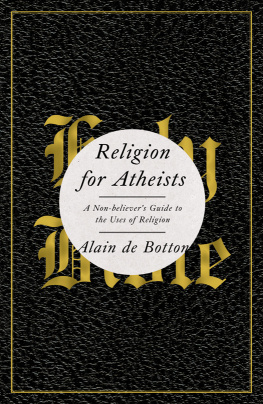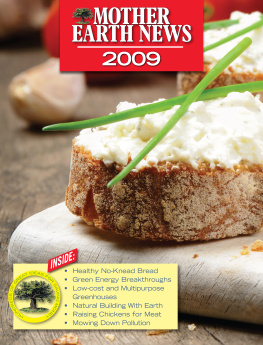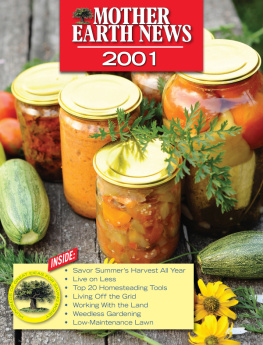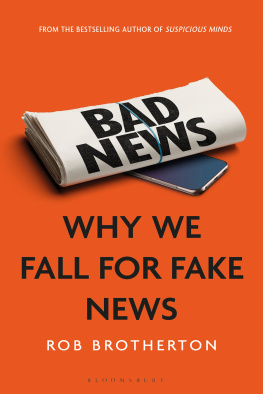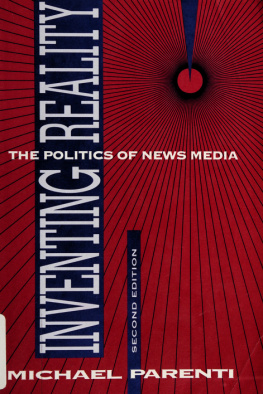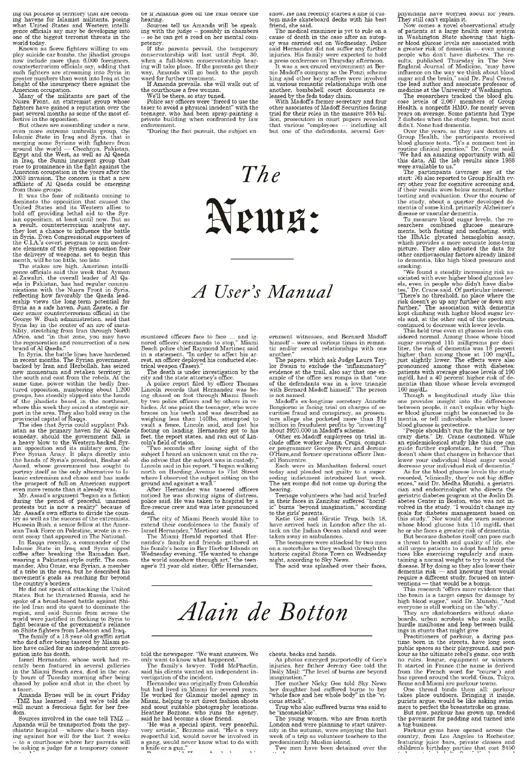Copyright 2014 by Alain de Botton
All rights reserved. Published in the United States by Pantheon Books, a division of Random House LLC, New York, and in Canada by McClelland & Stewart, a division of Random House of Canada Limited, Toronto, Penguin Random House companies. Originally published in Great Britain by Hamish Hamilton, an imprint of the Penguin Group, London.
Pantheon Books and colophon are registered trademarks of Random House LLC.
Grateful acknowledgment is made to New Directions Publishing Corp. and Carcanet Press Limited for permission to reprint an excerpt from Asphodel, That Greeny Flower by William Carlos Williams from The Collected Poems: Volume II, 19391962, copyright 1944 by William Carlos Williams. Reprinted by permission of New Directions Publishing Corp. and Carcanet Press Limited.
Library of Congress Cataloging-in-Publication Data
De Botton, Alain.
The news : a users manual / Alain de Botton.
Pages cm
HC ISBN 978-0-307-37912-2. EBK ISBN 978-0-307-91172-8.
1. JournalismSocial aspects. 2. JournalismPolitical aspects. 3. Mass mediaSocial aspects. 4. Mass mediaPolitical aspects. 5. News audiences. I. Title.
PN4749.D43 2014 302.23dc23 2013031206
www.pantheonbooks.com
Jacket design by Matt Dorfman
v3.1
For my mother
Contents
I .
Preface
1.
IT DOESN T COME with any instructions, because its meant to be the most normal, easy, obvious and unremarkable activity in the world, like breathing or blinking.
After an interval, usually no longer than a night (and often far less; if were feeling particularly restless, we might only manage ten or fifteen minutes), we interrupt whatever we are doing in order to check the news . We put our lives on hold in the expectation of receiving yet another dose of critical information about all the most significant achievements, catastrophes, crimes, epidemics and romantic complications to have befallen mankind anywhere around the planet since we last had a look.
What follows is an exercise in trying to make this ubiquitous and familiar habit seem a lot weirder and rather more hazardous than it does at present.
2.
THE NEWS IS committed to laying before us whatever is supposed to be most unusual and important in the world: a snowfall in the tropics; a love child for the president; a set of conjoined twins. Yet for all its determined pursuit of the anomalous, the one thing the news skilfully avoids training its eye on is itself, and the predominant position it has achieved in our lives. Half of Humanity Daily Spellbound by the News is a headline we are never likely to see from organizations otherwise devoted to the remarkable and the noteworthy, the corrupt and the shocking.
Societies become modern, the philosopher Hegel suggested, when news replaces religion as our central source of guidance and our touchstone of authority. In the developed economies, the news now occupies a position of power at least equal to that formerly enjoyed by the faiths. Dispatches track the canonical hours with uncanny precision: matins have been transubstantiated into the breakfast bulletin, vespers into the evening report. But the news doesnt just follow a quasi-religious timetable. It also demands that we approach it with some of the same deferential expectations we would once have harboured of the faiths. Here, too, we hope to receive revelations, learn who is good and bad, fathom suffering and understand the unfolding logic of existence. And here, too, if we refuse to take part in the rituals, there could be imputations of heresy.
The news knows how to render its own mechanics almost invisible and therefore hard to question. It speaks to us in a natural unaccented voice, without reference to its own assumption-laden perspective. It fails to disclose that it does not merely report on the world, but is instead constantly at work crafting a new planet in our minds in line with its own often highly distinctive priorities.
3.
FROM AN EARLY age, we are educated to appreciate the power of images and words. We are led to museums and solemnly informed that certain pictures by long-dead artists could transform our perspectives. We are introduced to poems and stories that might change our lives.
Yet, oddly, people seldom attempt to educate us about the words and images proffered to us every hour by the news. It is deemed more important for us to know how to make sense of the plot of Othello than how to decode the front page of the New York Post . We are more likely to hear about the significance of Matisses use of colour than to be taken through the effects of the celebrity photo section of the Daily Mail . We arent encouraged to consider what might happen to our outlooks after immersion in Bild or OK! magazine, the Frankfurter Allgemeine Zeitung or the Hokkaido Shimbun , the Tehran Times or the Sun . We are never systematically inducted into the extraordinary capacity of news outlets to influence our sense of reality and to mould the state of what we might as well with no supernatural associations call our souls.
For all their talk of education, modern societies neglect to examine by far the most influential means by which their populations are educated. Whatever happens in our classrooms, the more potent and ongoing kind of education takes place on the airwaves and on our screens. Cocooned in classrooms for only our first eighteen years or so, we effectively spend the rest of our lives under the tutelage of news entities which wield infinitely greater influence over us than any academic institution can. Once our formal education has finished, the news is the teacher. It is the single most significant force setting the tone of public life and shaping our impressions of the community beyond our own walls. It is the prime creator of political and social reality. As revolutionaries well know, if you want to change the mentality of a country, you dont head to the art gallery, the department of education or the homes of famous novelists; you drive the tanks straight to the nerve centre of the body politic, the news HQ.
4.
WHY DO WE, the audience, keep checking the news? Dread has a lot to do with it. After even a short period of being cut off from news, our apprehensions have a habit of accumulating. We know how much is liable to go wrong and how fast: an A380 may rupture its fuel line and cartwheel into the bay in flames, a virus from an African bat may leap the species barrier and infiltrate the air vents of a crowded Japanese commuter train, investors may precipitate a run on the currency and yet another deceptively ordinary father may call a violent end to the lives of his two beautiful young children.
In the immediate vicinity, there might well be stability and peace. In the garden, a breeze may be swaying the branches of the plum tree and dust may slowly be gathering on the bookshelves in the living room. But we are aware that such serenity does not do justice to the chaotic and violent fundamentals of existence and hence, after a time, it has a habit of growing worrisome in its own way. Our background awareness of the possibility of catastrophe explains the small pulse of fear we may register when we angle our phones in the direction of the nearest mast and wait for the headlines to appear. It is a version of the apprehension that our distant ancestors must have felt in the chill moments before dawn, as they wondered whether the sun would ever find its way back into the firmament.


